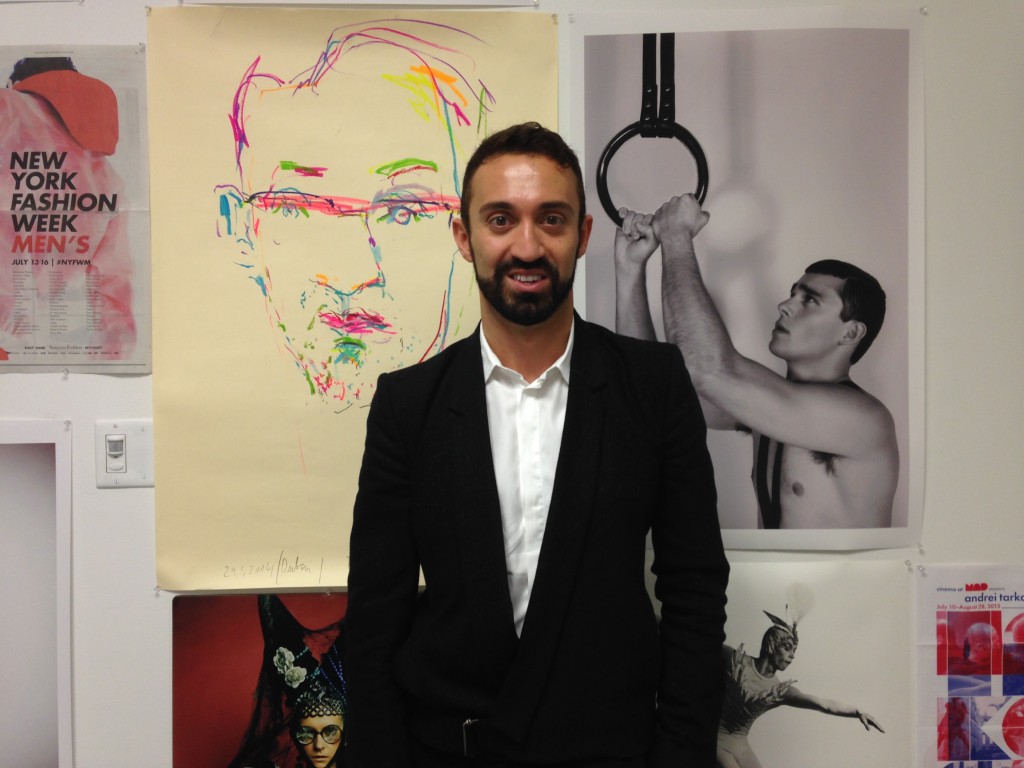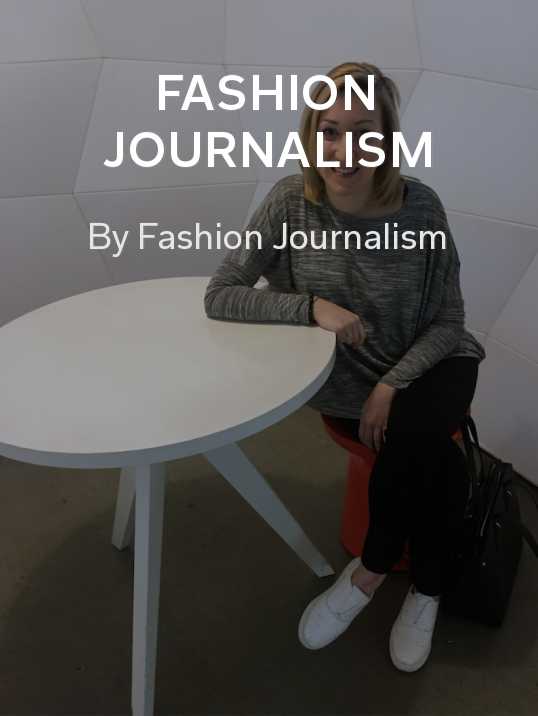On the Red Couch with Academy of Art University’s Stephan Rabimov
Educators / December 9, 2015
Thanks to platforms like Instagram and Twitter and the prevalence of micro-blogs, the world of fashion journalism is as wide-open as a busted seam. But with so many voices out there, questions about how to stand out from the crowd while maintaining high quality are as important as ever before.
“Fashion journalism is at the fault lines of tectonic shifts in media production and consumption,” says Stephan Rabimov, the Director of Fashion Journalism & Social Media Center at Academy of Art University in San Francisco. “According to the Wall Street Journal, time spent with digital media on smartphones grew 90% in the past two years. The competition is on for delivering information from designers to readers and consumers in the most relevant and entertaining way without losing one’s credibility. That’s why the revered fashion critic Suzy Menkes runs her own Instagram with backstage access and personality insights. Writing for Vogue—once an end-all prerogative—is no longer enough to maintain zeitgeist clout.”
And of course, these days, it’s not enough to make content—you have to be skilled in the art of packaging and distribution, too. All of this is covered at Academy of Art University, which hosts the only designated and accredited fashion journalism BA and MA programs in the United States.
As part of that program, Fashion Journalism classes use Flipboard to showcase students’ work, class discussions, industry trends and relevant news. We connected with Rabimov (who’s also a contributing writer to The Huffington Post and a founder of DEPESHA, a leading Russian luxury lifestyle magazine) in his downtown San Francisco office to discuss just how you should teach fashion journalism today and how sites like Reddit can be great sources of inspiration.
Why is San Francisco the right place for a fashion journalism program? It’s not exactly the epicenter of the industry.
It’s a question I first asked myself as I was deciding to move from New York City to San Francisco. Silicon Valley is the de facto digital capital of the world. It is here that some of the most innovative apps and tech products originated, that also have a direct impact on fashion journalism. I was thrilled to join the Academy of Art University at the heart of the most creative community in San Francisco, and at the same time have an opportunity to work with companies like Facebook, Twitter, Weebly and Flipboard that have revolutionized digital media.
Moreover, we’re at this special moment in history when technology and fashion are finally merging into something incredible. The rise of wearable tech is a good signifier as to the types of things that people are thinking about in terms of intersections and collaborations between these two fields.
What’s unique about fashion journalism versus other kinds of journalism?
Some things aren’t that different. Storytelling is at the core of fashion and at the heart of journalism. Modes of putting together and delivering narratives continue to evolve but a good story will always capture and delight. Fashion journalists might specialize in a chosen field, like recurring trends, but should still exhibit a solid grasp on overall industry realities. In a sense, they are like social scientists.
The modern fashion journalist’s role is to position fashion as a platform beyond product marketing, addressing issues of race, gender identity, disability and geopolitics. For example, Robin Givhan, the only Pulitzer Prize winning fashion journalist, focused on forgiveness and hope in a post-9/11 Givenchy review for The Washington Post, while The Guardian chronicled the rise of Iranian models on the global scene at a poignant moment in the latest nuclear disarmament talks.
Fashion transcends borders and cultures, and wearing clothes is a daily ritual shared by billions of people. The field of fashion journalism, with its ever-expanding influence on socio-cultural elements, creates a richer story than a standard news report or broadcast. Magazines and blogs don’t always break news, but they are the source of analysis, information and voices that help readers make decisions or get inspired.
Who are the voices in fashion journalism today that you think everyone should know?
In addition to Cathy Horyn, Suzy Menkes and Robin Givhan, I am a fan of Imran Amed‘s Business of Fashion, because it’s at the forefront of capturing fashion industry’s zeitgeist. The dimension of voices BoF offers, including the recent addition of Tim Blanks, is unparalleled.
Nick Knight’s SHOWstudio is always at the bleeding-edge of creativity. Knight founded what we define now as fashion film: an intersection of moving image, editorial, storytelling and style. As mobile videos rise, so will fashion film, so we will be hearing about Knight’s work even more frequently.
How important is the visual in fashion journalism?
With over 300 million Instagrammers and more than 1.5 billion active Facebook accounts, the market for quality visual content is exponential. So are other, yet unfathomable, business models. Platforms like Tumblr, Pinterest, Squarespace, Snapchat and WhatsApp, among many others, enable fashion journalists to reach increasingly diverse audiences. First impressions matter in fashion, and visual content is online’s first impression.
What do you advise when it comes to social media? What platforms do you recommend to students and how do you suggest they use them?
Millennials—the largest generation joining the workforce—are uniquely purpose-driven and most engaged across social networks. We never cease to search for meaningful connections and sustainable practices. Fashion journalism is inherently wired for positive change and for building bridges. Social media is an embedded essential element of modern journalism. While many millennials understand how to use social media tools, at the Academy we focus on why social media is important and where it is heading. Social media is changing, and it is important to ask ourselves a similar question: Are we changing too? This is why an academic environment where most of the fundamental learning occurs mixes so well with the ever-changing landscape of social media. In many ways, academia is an incubator, the time to experiment, fail, learn, test again and create effective solutions. It is not much different from working with social media.
Recently we had an opportunity to engage with an emerging new tool called Fyuse, a ‘spatial photography’ app which lets users capture and share interactive representations of the world. We see its big potential for many fields and encourage our students to understand and apply this rising technology. Last semester, we focused on Periscope and Percolate apps during one week, resulting in an immense amount of student feedback that we were able to pass on to apps’ founders. Understanding proven tools, while experimenting with what’s around the corne, is how our program sets itself apart from the competition.
Where do you encourage students to go to find inspiration?
Read Reddit; really dive into different threads that are pertinent to your interests and industry. Students can get access to underground discussions, emerging industry issues and questions across those threads. There’s even a thread on blogging where people share their experiences of various strategies and tools. There’s a thread on fashion, fashion and technology, fashion accessories, beauty, etc. There’s no such thing as the smallest niche/topic on Reddit.
Over time, as students become experts through education and experience, Reddit users can become topic moderators—a very powerful place to be and it adds to their professional credibility. This position offers the responsibility to curate information on “the front page of the Internet,”and so that’s always a good place to be for fashion journalism.
At the end of the day, it’s not only about digital or social. There’s also the physical experience of living life outside of the computer realm. We encourage our students to get out there and visit galleries, museums, to attend industry events to network, connect and not just always sit in front of their computers. It’s important to do all of this together—all of these methods are important, building upon one another is how anyone can become an extremely successful professional in any industry.
Check out Academy of Art University’s Fashion Journalism Flipboard Magazine:
~MiaQ is curating Fashion Plates
GET FLIPBOARD ON:
FOLLOW US ON:
FLIPBOARD / TWITTER / INSTAGRAM / FACEBOOK / GOOGLE+ /TUMBLR /YOUTUBE / SOUNDCLOUD / PINTEREST / MEDIUM







